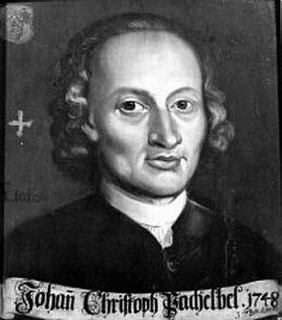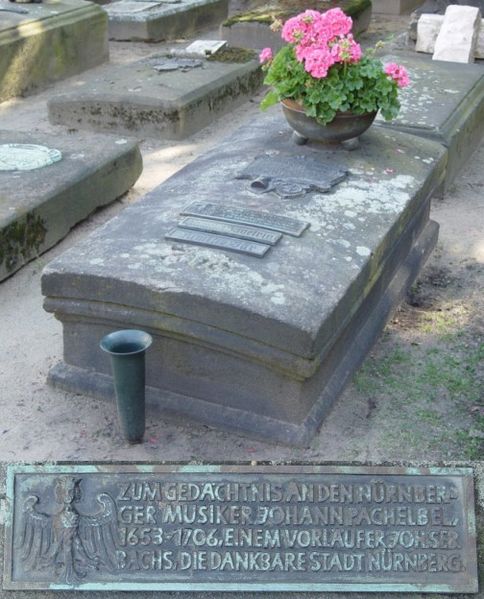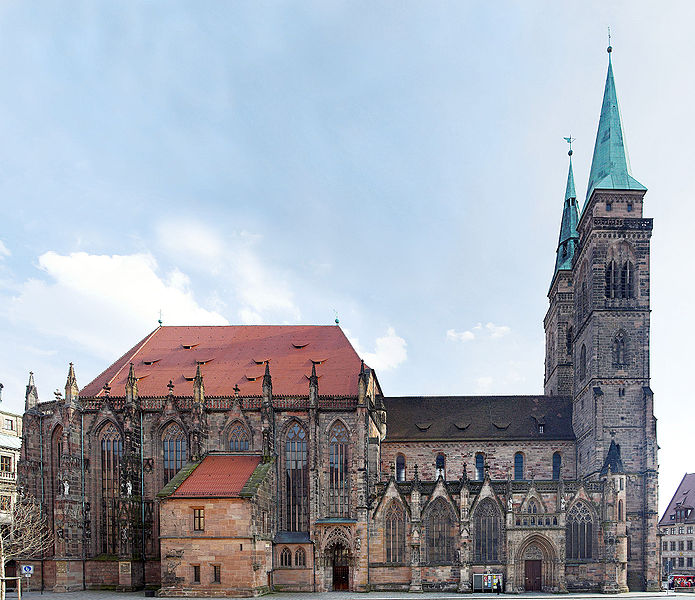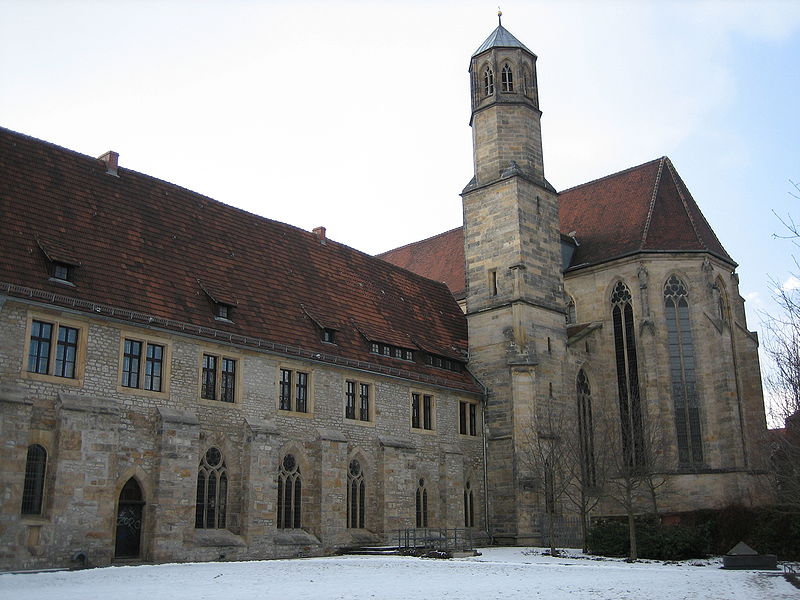<Back to Index>
- Physician Andrija Štampar, 1888
- Composer Johann Pachelbel, 1653
- President of the Dominican Republic Joaquín Antonio Balaguer Ricardo, 1906
PAGE SPONSOR


Johann Pachelbel (baptized September 1, 1653 – buried March 9, 1706) was a German Baroque composer, organist and teacher, who brought the south German organ tradition to its peak. He composed a large body of sacred and secular music, and his contributions to the development of the chorale prelude and fugue have earned him a place among the most important composers of the middle Baroque era.
Pachelbel's
music enjoyed enormous popularity during his lifetime; he had many
pupils and his music became a model for the composers of south and
central Germany. Today, Pachelbel is best known for the Canon in D, the only canon he wrote - although a true canon at the unison in three parts, it is often regarded more as a passacaglia,
and it is in this mode that it has been arranged and transcribed for
many different media. In addition to the canon, his best known
works include the Chaconne in F minor, the Toccata in E minor for organ, and the Hexachordum Apollinis, a set of keyboard variations. Pachelbel's music was influenced by southern German composers, such as Johann Jakob Froberger and Johann Kaspar Kerll, Italians such as Girolamo Frescobaldi and Alessandro Poglietti, French composers, and the composers of the Nuremberg tradition. He preferred a lucid, uncomplicated contrapuntal style that emphasized melodic and harmonic clarity. His music is less virtuosic and less adventurous harmonically than that of Dieterich Buxtehude, although, like Buxtehude, Pachelbel experimented with different ensembles and instrumental combinations in his chamber music and, most importantly, his vocal music, much of which features exceptionally rich instrumentation. Pachelbel explored many variation forms
and associated techniques, which manifest themselves in various diverse
pieces, from sacred concertos to harpsichord suites. Johann Pachelbel was born in 1653 in Nuremberg into a middle class family, son of Johann (Hans) Pachelbel (1613 in Wunsiedel, Germany), a wine dealer, and his second wife Anna (Anne) Maria Mair. The exact date of Johann's birth is unknown, but since he was baptized on September 1, he may have been born in late August. During
his early youth, Pachelbel received musical training from Heinrich
Schwemmer, a musician and music teacher who later became the cantor of St. Sebaldus Church (Sebalduskirche). Some sources indicate that Pachelbel also studied with Georg Caspar Wecker, organist of the same church and an important composer of the Nuremberg school, but this is now considered unlikely. In any case, both Wecker and Schwemmer were trained by Johann Erasmus Kindermann, one of the founders of the Nuremberg musical tradition, who had been at one time a pupil of Johann Staden. Johann Mattheson, whose Grundlage einer Ehrenpforte (Hamburg,
1740) is one of the most important sources of information about
Pachelbel's life, mentions that the young Pachelbel demonstrated
exceptional musical and academic abilities. He received his primary education in St. Lorenz Hauptschule and the Auditorio Aegediano in Nuremberg, then on 29 June 1669 became a student at the University of Altdorf,
where he was also appointed organist of St. Lorenz church the same
year. Financial difficulties forced Pachelbel to leave the university
after less than a year. In order to complete his studies he became a
scholarship student, in 1670, at the Gymnasium Poeticum at Regensburg.
The school authorities were so impressed by Pachelbel's academic
qualifications that he was admitted above the school's normal quota. Pachelbel was also permitted to study music outside the Gymnasium. His teacher was Kaspar (Caspar) Prentz, once a student of Johann Kaspar Kerll. Since the latter was greatly influenced by Italian composers such as Giacomo Carissimi, it is likely through Prentz that Pachelbel started developing an interest in contemporary Italian music, and Catholic church music in general. Prentz left for Eichstätt in 1672. This period of Pachelbel's life is the least documented one, so
it is unknown whether he stayed in Regensburg until 1673 or left the
same year his teacher did; at any rate, by 1673 Pachelbel was living in Vienna, where he became a deputy organist at the famous Saint Stephen Cathedral (Stephansdom). At the time, Vienna was the center of the vast Habsburg empire and had much cultural importance; its tastes in music were predominantly Italian. Several renowned cosmopolitan composers worked there, many of them contributing to the exchange of musical traditions in Europe. In particular, Johann Jakob Froberger served as court organist in Vienna until 1657 and was succeeded by Alessandro Poglietti. Georg Muffat lived in the city for some time, and, most importantly, Johann Kaspar Kerll moved to Vienna in 1673. While
there, he may have known or even taught Pachelbel, whose music shows
traces of Kerll's style. Pachelbel spent five years in Vienna,
absorbing the music of Catholic composers from southern Germany and Italy, whose styles contrasted with the more strict Lutheran tradition he was bred in. In some respects, Pachelbel is similar to Haydn, who too served as a professional musician of the Stephansdom in his youth and as such was exposed to music of the leading composers of the time. In 1677, Pachelbel moved to Eisenach, where he found employment as court organist under Kapellmeister Daniel Eberlin (also a native of Nuremberg), in the employ of Johann Georg I, Duke of Saxe - Eisenach. He met members of the Bach family in Eisenach (which was the home city of J.S. Bach's father, Johann Ambrosius Bach), and became a close friend of Johann Ambrosius and tutor to his children. However, Pachelbel spent only one year in Eisenach. In 1678, Bernhard II, Duke of Saxe - Jena, Johann Georg's brother, died and during the period of mourning court musicians were greatly curtailed. Pachelbel
was left unemployed. He requested a testimonial from Eberlin, who wrote
one for him, describing Pachelbel as a 'perfect and rare virtuoso' — einen perfecten und raren Virtuosen. With this document, Pachelbel left Eisenach on May 18, 1678. In June 1678, Pachelbel was employed as organist of Predigerkirche in Erfurt, succeeding Johann Effler (c. 1640 – 1711; Effler later preceded Johann Sebastian Bach in Weimar).
The Bach family was very well known in Erfurt (where virtually all
organists would later be called "Bachs"), so Pachelbel's friendship
with them continued here. Pachelbel became godfather to
Johann Ambrosius' daughter, Johanna Juditha, taught Johann Christoph
Bach (1671 – 1721), Johann Sebastian's eldest brother, and lived in
Johann Christian Bach's (1640 – 1682) house. Pachelbel
remained in Erfurt for 12 years and established his reputation as one
of the leading German organ composers of the time during his stay. The chorale prelude became
one of his most characteristic products of the Erfurt period, since
Pachelbel's contract specifically required him to compose the preludes
for church services. His
duties also included organ maintenance and, more important, composing a
large scale work every year to demonstrate his progress as composer and
organist, as every work of that kind had to be better than the one
composed the year before. Johann Christoph Bach, Pachelbel's landlord in Erfurt, died in 1682. In June 1684, Pachelbel purchased the house (called Zur silbernen Tasche, now Junkersand 1) from Johann Christian's widow. In 1686, he was offered a position as organist of the St. Trinitatis church (Trinitatiskirche) in Sondershausen.
Pachelbel initially accepted the invitation but, as a surviving
autograph letter indicates, had to reject the offer after a long series
of negotiations: it appears that he was required to consult with
Erfurt's elders and church authorities before considering any job
offers. It
seems that the situation has been resolved quietly and without harm to
Pachelbel's reputation; he was offered a raise and stayed in the city
for four more years. Pachelbel
married twice during his stay in Erfurt. Barbara Gabler, daughter of
the Stadt - Major of Erfurt, became his first wife, on October 25, 1681.
The marriage took place in the house of the bride's father.
Unfortunately, both Barbara and their only son died in October 1683
during a plague. Pachelbel's first published work, a set of chorale variations called Musicalische Sterbens - Gedancken ("Musical Thoughts on Death", Erfurt, 1683), was probably influenced by this event. Ten months later, Pachelbel married Judith Drommer (Trummert), daughter of a coppersmith, on August 24, 1684. They had five sons and two daughters. Two of the sons, Wilhelm Hieronymus Pachelbel and Charles Theodore Pachelbel, also became organ composers; the latter moved to the American colonies in 1734. Another son, Johann Michael, became an instrument maker in Nuremberg and traveled as far as London and Jamaica. One of the daughters, Amalia Pachelbel, achieved recognition as a painter and engraver. Although
Pachelbel was an outstandingly successful organist, composer, and
teacher at Erfurt, he asked permission to leave, apparently seeking a
better appointment, and was formally released on August 15, 1690,
bearing a testimonial praising his diligence and fidelity. He was employed in less than a fortnight: from September 1, 1690, he was a musician - organist in the Württemberg court at Stuttgart under the patronage of Duchess Magdalena Sibylla. That job was better, but, unfortunately, he lived there only two years before fleeing the French attacks of the War of the Grand Alliance. His next job was in Gotha as the town organist, a post he occupied for two years, starting on November 8, 1692; there he published his first, and only, liturgical music collection: Acht Chorale zum Praeambulieren in 1693 (Erster Theil etlicher Choräle). When former pupil Johann Christoph Bach married in October 1694, the Bach family celebrated the marriage on October 23, 1694 in Ohrdruf, and invited him and other composers to provide the music; he probably
attended — if so, it was the only time J.S. Bach, then nine years old,
met Johann Pachelbel. In his three years in Gotha, he was twice offered positions, in Stuttgart and at Oxford University;
he declined both. Meanwhile, in Nuremberg, when the St. Sebaldus Church
organist Georg Caspar Wecker (and his possible former teacher) died on
April 20, 1695, the city authorities were so anxious to appoint
Pachelbel (then a famous Nuremberger) to the position that they
officially invited him to assume it without holding the usual job
examination or inviting applications from prominent organists from
lesser churches. He accepted, was released from Gotha in 1695, and
arrived in Nuremberg in summer, with the city council paying his per
diem expenses. Pachelbel lived the rest of his life in Nuremberg, during which he published the chamber music collection Musicalische Ergötzung, and, most important, the Hexachordum Apollinis (Nuremberg, 1699), a set of six keyboard arias
with variations. Though most influenced by Italian and southern German
composers, he knew the northern German school, because he dedicated the Hexachordum Apollinis to Dieterich Buxtehude. Also composed in the final years were Italian - influenced concertato Vespers and a set of more than ninety Magnificat fugues. Johann
Pachelbel died at the age of 52, March 3, 1706, and was buried on 9
March; Mattheson cites either 3 or 7 March 1706 as the death date; yet,
it is unlikely that the corpse was allowed to linger unburied so long.
Contemporary custom was to bury the dead on the third or fourth
post-mortem day; so, either 6 or 7 March 1706 is a likelier death date. Johann Pachelbel is buried in the St. Rochus Cemetery. One
of the last middle Baroque composers, Pachelbel did not have any
considerable influence on most of the famous late Baroque composers, such as George Frideric Handel, Domenico Scarlatti or Georg Philipp Telemann. He did influence Johann Sebastian Bach indirectly; the young Johann Sebastian was tutored by his older brother Johann Christoph Bach,
who studied with Pachelbel, but although JS Bach's early chorales and
chorale variations borrow from Pachelbel's music, the style of northern
German composers (Georg Böhm, Dieterich Buxtehude, Johann Adam Reincken) played a more important role in the development of Bach's talent. Pachelbel
was the last great composer of the Nuremberg tradition and the last
important southern German composer. Pachelbel's influence was mostly
limited to his pupils, most notably Johann Christoph Bach, Johann Heinrich Buttstett, Andreas Nicolaus Vetter, and two of Pachelbel's sons, Wilhelm Hieronymus and Charles Theodore. The latter became one of the first European composers to take up residence in the American colonies and so Pachelbel influenced, although indirectly and only to a certain degree, the American church music of the era. Composer, musicologist and writer Johann Gottfried Walther is probably the most famous of the composers influenced by Pachelbel – he is, in fact, referred to as the "second Pachelbel" in Mattheson's Grundlage einer Ehrenpforte. As
the Baroque style went out of fashion during the 18th century, the
majority of Baroque and pre-Baroque composers were virtually forgotten.
Local organists in Nuremberg and Erfurt knew Pachelbel's music and
occasionally performed it, but the public and the majority of composers
and performers did not pay much attention to Pachelbel and his
contemporaries. In the first half of the 19th century, some organ works
by Pachelbel were published and several musicologists started considering him an important composer, particularly Philipp Spitta,
who was one of the first researchers to trace Pachelbel's role in the
development of Baroque keyboard music. Much of Pachelbel's work was
published in the early 20th century in the Denkmäler der Tonkunst in Österreich series, but it was not until the rise of interest in early Baroque music in the middle of the 20th century and the advent of historically informed performance practice and associated research that Pachelbel's works began to be studied extensively and again performed more frequently.
Pachelbel's Canon in D major, a piece of chamber music scored for three violins and basso continuo and originally paired with a gigue in the same key, experienced a tremendous surge in popularity during the 1970s. This is believed to be due to a recording by Jean - François Paillard in
1970 which made it a universally recognized cultural item. Now one of
the most recognised and famous baroque compositions, it has in recent
years become extremely popular for use in weddings, rivalling that of Wagner's Bridal Chorus.

